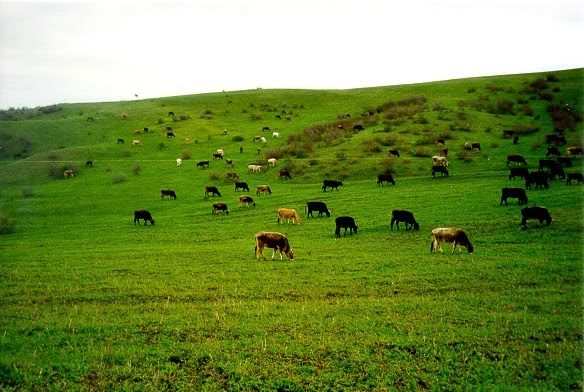
By:
Muhammad Tegar K.K., S.Pt
First Expert Livestock Breeding Supervisor
Pasture or grazing field is a land used for grazing and a source of fresh forage for livestock. Another definition of pasture is an area where livestock feed plants grow that are available for animals to graze according to their needs in a short period of time (Reksohadiprodjo, 1994). According to Parakkasi (1999), Pasture is a fenced field covered with superior quality forage used for grazing ruminant animals. Grazing fields can consist of grasses, legumes, or a combination of both (McIlroy, 1976), where the function of legumes in grazing fields is to provide better nutritional value, especially in terms of protein, phosphorus, and potassium (Reksohadiprodjo, 1994).
Good characteristics of Pasture include high dry matter production, high nutrient content, especially crude protein, resistance to grazing and trampling as well as drought during the dry season, easy maintenance, rapid growth, high leaf-to-stem ratio, easy development when combined with legume plants, cost-effective, and high palatability.
Quantity and Quality of Pasture
Quantity of Pasture is described as herbage mass or plant height. Herbage mass is expressed in kg DM/ha. Herbage mass is the total amount of pasture when cut, including both the fresh and dead parts. Herbage mass is given in dry matter because the moisture content of pasture can vary depending on the season and growth stage. The components of Pasture used to determine herbage mass are height, density, and moisture content. The herbage mass value for sheep is 400 – 1700 kg DM/ha and for cattle 700 – 2900 kg DM/ha. A lower herbage mass value means that animals require more time to graze to meet their nutritional needs. In addition to herbage mass, plant height is also used to determine the quantity of Pasture (Bell, 2006).
Good characteristics of Pasture include high dry matter production, high nutrient content, especially crude protein, resistance to grazing and trampling as well as drought during the dry season, easy maintenance, rapid growth, high leaf-to-stem ratio, easy development when combined with legume plants, cost-effective, and high palatability.
Types of Pasture (Grazing Fields)
Types of Grazing Fields Grazing fields can be classified into four main categories: Natural Grazing Fields, Improved Permanent Grazing Fields, Artificial (Temporary) Grazing Fields, and Irrigated Grazing Fields.
- Natural Grazing Fields: This group includes species of livestock feed plants that have not been intentionally planted or sown and their flora is relatively untouched by human interference (McIlroy, 1976). Reksohadiprodjo (1994) adds that humans only oversee the grazing animals. The animals move naturally. According to McIllroy (1976), the appropriate inclusion of legumes to form mixed grass or legume stands and the regulation of grazing are crucial first steps in improving these grass fields.
- Improved Permanent Grazing Fields: The forage species in this group have not been sown or planted, but the botanical composition has been altered by careful grazing management or by practices like cutting, drainage, fertilizer use, soil cultivation, replanting, and weed control (McIlroy, 1976).
- Artificial (Temporary) Grazing Fields: The forage plants in these fields have been intentionally planted, sown, and cultivated by humans. These fields can be permanent or alternate with crops (Reksohadiprodjo, 1994). According to Susetyo (1980), temporary grazing fields are categorized into short-term and long-term. Short-term fields are used for 3-4 years, with intercropped agricultural crops to improve soil fertility. Long-term fields are used for 6-10 years, and after about 10 years, the field is directly renovated, without intercropping.
- Irrigated Grazing Fields: These fields are usually located along rivers or near water sources. Grazing is done after the field has been irrigated for 2 to 4 days. Irrigated grazing can be done extensively, semi-extensively, by strip-grazing, or by zero-grazing, where forage is cut by humans and given to animals in pens (Reksohadiprodjo, 1994). To maintain high yields, heavily fertilizing irrigated grazing fields is necessary (McIlroy, 1976).
Factors to Consider in Pasture Management
Botanical composition of grazing fields is not always constant. Changes in component composition occur due to seasonal influences, soil conditions, and grazing systems. The composition of a field is affected by rainfall, altitude, and grazing management. The botanical composition of a grass field is largely determined by its management (McIlroy, 1976). Furthermore, heavy early-season grazing followed by a resting period tends to suppress early-maturing plant species and favor slow-growing types. Conversely, delaying grazing until later in the season has the opposite effect.
Soil type is related to soil fertility and determines the number of plants that can be grown. Most grasses and legumes thrive at pH levels above 6.0. Sandy soils are not suitable for pasture, while volcanic and alluvial soils are ideal for plant growth. According to the Oregon Department of Agriculture (2009), all types of soil are suitable for planting tall fescue, red clover, white clover, birdsfoot trefoil. Dry, shallow, well-drained soils are suitable for alfalfa, orchardgrass, perennial ryegrass. Water-deficient soils are suitable for alsike clover, big trefoil, and perennial ryegrass. Mixed-drainage soils, highlands, and terraces are suitable for alfalfa, orchardgrass, perennial ryegrass, alsike clover, big trefoil.
Climate determines plant growth and also affects water content and overall nutrient quality in feed plants. A composition of grass and one or two types of legumes results in higher forage quality than a more complex combination. A simple combination also facilitates grazing management, which is important for maintaining production stability, desired plant composition, and land coverage density. Topographical factors such as land elevation and slope influence Pasture quality by determining environmental temperature and sunlight intensity. Grazing management must be carefully regulated, considering land carrying capacity and utilization to avoid environmental damage and meet livestock forage needs (Casale, 2012).
Appropriate pasture management can increase forage production, reduce weed populations, prevent erosion, reduce expenses for feed, herbicides, and fertilizers, prevent soil compaction, and nutrient loss (Oregon Department of Agriculture, 2009).
References
Casale, R. 2012. Pasture Management. Natural Resources Conservation Service (NRCS) Office, Oregon.
Oregon Department of Agriculture. 2009. Pasture Management For Small Acreage Animal Owners. Natural Resources Conservation Service (NRCS) Office, Oregon.
Parakkasi, A. 1999. Ilmu Makanan Ternak Ruminansia. First Edition. Universitas Indonesia Press, Jakarta.
Reksohadiprodjo, S. 1985. Produksi Tanaman Hijauan Makanan Ternak Tropis. Second Edition. BPFE. Universitas Gadjah Mada, Yogyakarta.



